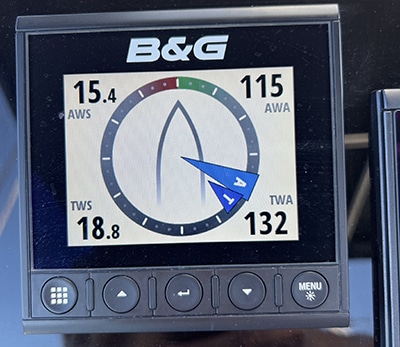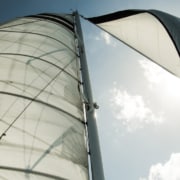“As the wind, so the sails.” –sailing proverb
If you’ve been sailing for any amount of time, you’ve learned that the wind is fickle and unpredictable. It’s unavoidably central to the experience, yet it can be very frustrating to learn how to harness it. What makes it more complicated is the fact that there are actually two different types of wind: true wind and apparent wind (ok well actually three – ground wind but that’s another topic and will only serve to complicate things here).
So, what is apparent wind?
Apparent wind is the wind you feel when you’re moving, as compared to “true wind.” True wind is the actual wind that is blowing. It’s the speed and angle of the wind you would feel if you were standing still. Apparent wind, on the other hand, is the wind you begin to experience when you’re moving. Both the speed and angle of apparent wind can vary depending on your velocity, which has important implications for sailing. How do they vary? Let’s talk about that!
Apparent Wind Speed
Imagine you’re standing still in a field and there’s a 10 kph breeze blowing into your face. That’s the true wind. Now imagine you start running into the wind at 5 kph. The speed of the wind you’re experiencing now is 15 kph. Simple enough, right? Now imagine, for example, you turn around and start running 10 kph in the opposite direction – going in the same direction as the true wind. Now you would have the peculiar sensation of experiencing no wind. This is because your speed is matching the true wind speed and direction. You’ve probably experienced this if you’ve ridden your bike or put your hand out of a moving vehicle.
Apparent Wind Angle
The speed of apparent wind also changes with the direction you are heading relative to the wind direction. This phenomenon explains why you can experience the intensity of the wind differently depending on your sailing angle to the wind and the speed of your vessel. The faster you move, the more the apparent wind angle changes. To put it at its most simple, the angle of the apparent wind moves closer to your front the faster you go.
Let’s imagine your hand out the window of a car traveling at 100 kph. And part of this imaginary story has the true real wind at 10 kph from the side of the car. Keep imagining – the car is traveling across the wind. Your hand will almost feel all the wind coming from the front of the car – right? It’s because the car is going so fast – 100kph compared to 10 kph wind from the side. Pythagoras would tell us that our hand would feel 100.5 kph ever so slightly at an angle towards the side of the car – so slight that your hand could not tell the angle. Slow the car to 10 kph, and you would feel the wind at 45 degrees from the side and front. As you increase speed again, the wind you feel on your hand (apparent wind) would feel increasing and more and more from the front. Thus, the angle of the wind you experience changes with your velocity.
Apparent Wind example from the free Basic Sail Trim course. As the car accelerates, the apparent wind moves further forward. Give it a try!
This apparent wind phenomenon has an impact on the way you trim your sails. Imagine you are on a sailboat on a beam reach (traveling sideways to a 15-knot true wind breeze – meaning at a standstill, the wind would come directly across your boat). Now, tele-transport onto an Americas Cup boat where they have water foils so that the boat picks up and starts traveling at 50 knots. The wind vectors are 15 knots from the side and 50 knots from the front. A few Cosine and Sine calculations and a consultation with Pythagoras will give you a 52 kph wind at 17 degrees of the bow. Well, now you have to retrim your sails because the wind is no longer coming from the side of the boat but from just off the front of the boat. But wait – the true wind is still only 15 kph and the boat is going 50 kph??? Yes – that is how the America’s Cup boats work – they can go faster than the wind. Apparently, this is true!
Sailing with Apparent Wind – the basics
As learned above, and as a general rule, as the sailboat’s speed increases then the apparent wind increases while the apparent wind angle moves to come more from the front of the boat (moves forward) (again think of your hand out the window of a car).
Thus, a challenge in sailing is that the True wind rarely is constant and continually changes as well. This is most noticeable with gusts of wind when the true wind speed can dramatically increase and decrease.
All you can do is trim your sails to the apparent wind because the boat feels only the apparent wind (you see the effects in the sail tell tales and the wind vane. BUT, the since mechanics of the apparent wind include true wind, any change in either will affect what the boat feels and will likely require additional trimming.
Clear as mud, right?! A few concepts help here…
SAILING IN UPWIND ANGLES:
- When sailing in upwind angles, the apparent wind is going to be stronger than the true wind because the winds are additive at their respective angles. The angle of the wind you feel moves like it is coming more from the front of the boat than the true wind.
- If true wind increases in velocity, momentarily, the apparent wind angle moves aft. This means you and the boat feel like the wind now has changed to come less from the front of the boat than you experienced a moment ago and more towards the angle where the true wind is coming from. The sailboat will experience a temporary “lift” and allows you to turn the boat more towards an upwind direction. However, once the boat speeds back up the temporary lift will go away.
- Conversely, if sailing upwind and true wind decreases, then the apparent wind angle moves forward briefly until the boat slows. The sailboat will experience a “header” or “knock” that points you more downwind.
REACHING: The effects are much the same as when sailing upwind. Changes in true wind speed may give you a temporary lift or knock.
SAILING CLOSE TO DIRECT DOWNWIND: When sailing downwind, the apparent wind is typically weaker than true wind – like riding your bicycle away from the wind. True wind velocity changes have less of an effect on the angle change of apparent wind but it is not insignificant. You still need to monitor and trim your sails for the ever-changing apparent wind angle.
Below is a picture of a real wind meter on a sailboat that was sailing at a true wind angle (TWA) of 132 degrees away from where the wind comes from. Notice that because of the speed and direction of the boat, the apparent wind angle (AWA) was 115 degrees and that the apparent wind speed (AWS) was less than the true wind speed (TWS) because the boat was going downwind.
WARNING: a common mistake when sailing downwind is that the wind ‘feels’ calmer (since you’re going with the true wind), and so sailors may be tempted set more sail than is safe for conditions when turning upwind (whense apparent wind will significantly increase). Wind is a ‘force multiplier” on the sails by the square of the velocity change, and so if sailing in stronger winds or gusty conditions you may be quickly overpowered. Simply consider this as you trim your sails, and reef as needed for upwind and apparent wind conditions.
Where to learn more (and practice)
Fortunately, if you don’t have a degree in trigonometry, there are some great resources to help you get a better grasp of this fascinating concept. If your boat isn’t already equipped with one, you can purchase an anemometer that will electronically feed the information to a wind meter as in the picture above. These devices help you see the speed and angle of the apparent wind.
In terms of getting a better grasp of the concept – and YES, it gets more complicated (tides/currents, winds aloft, etc…) – we’re pretty partial to the free NauticEd’s Basic Sail Trim Course. We have helpful animations that give you an interactive way to see the impact of both the speed and angle of apparent wind on a moving vehicle. In fact, NauticEd has several courses that touch on the apparent wind, since it’s such a central concept for sailors, but the Basic Sail Trim Course is a great place to get started.
Another excellent course discussing apparent wind is the NauticEd Electronic Navigation course. The course also covers much of the remaining electronic devices on a modern equipped sailboat.
One of the joys of sailing is learning the concepts that help you master the techniques. There’s the physical side – learning to tie knots, set and trim the sails, steer the boat, etc. but then there’s the theoretical or mental side – learning how to read and understand the wind and weather, how to work with the tides and currents (if you’re ocean sailing), how to understand and read nautical charts, etc. For those who maybe have had some exposure to sailing, but haven’t had expert instruction, a concept like this might be new. Getting a solid grasp of apparent wind will help you become a stronger sailor and make your experience that much better whenever you’re out on the water. It’s one of those concepts that gives you a major level up in competency (something we’re pretty keen on — if you haven’t noticed).










